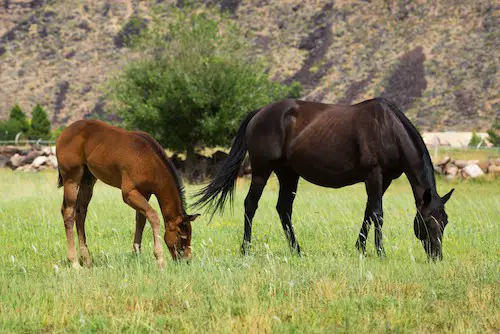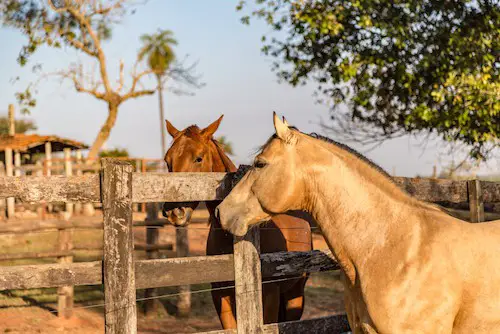For a long time, Thoroughbreds and Quarter Horses have been regarded as some of the best racing horse breeds. However, these horses are actually tailored for different racing terrains. Quarter Horses are suitable for short races and jumping. However, for Thoroughbreds, they’re more suited to long-distance races.
In spite of their similarities in usefulness, Thoroughbreds and Quarter Horses have a lot of dissimilarities. For instance, Quarter Horses are calm and mellow, meaning they’re suitable for beginners and inexperienced riders. On the other hand, Thoroughbreds are quite unruly and high-spirited. They need trainers with experience in managing horses with such temperament.
These aren’t the only differences that exist between Quarter Horses and Thoroughbreds. Keep reading to learn more about the differences between both breeds.
Size
Regarding size and appearance, these horse breeds are incredibly similar. However, if you take a better look, you’ll notice that there are actually a few differences that will help to set them apart.
Thoroughbreds usually stand at about 62 – 68 inches while weighing around 800 – 1200 pounds. Also, they generally have a lean, athletic, and toned appearance. However, a Quarter Horse stands at a height of around 56 – 64 inches, while weighing approximately 1200 pounds. In addition, they usually have short heads, broad chests, and have a muscular appearance in general.

Even with their slim and lean build, the Thoroughbred has a stronger and more solid look. Meanwhile, the Quarter Horse is shorter, wider, and more muscular than its counterpart. Both these horse breeds are very popular and can be found in colors like brown, gray, and black. However, Quarter horses normally come in more colors.
Both breeds have solid fur with markings on their faces and under their knees.
Speed And Racing
Quarter horses and Thoroughbreds are known for their racing abilities. One question that a lot of people need an answer to is: Who is the faster of the two?
Normally, Thoroughbreds possess average maximum speeds of 40 mph. On the other hand, Quarter horses are able to run at around 55 mph. In all honesty, it majorly depends on the type of race being held. These horse breeds perform differently when in different categories.
Compared to Thoroughbreds, a Quarter Horse has a consistent speed. What this means is that if they start a race well, there’s a high probability that they will finish well. However, if they begin poorly, it will be hard to go up a notch. Due to this reason, Quarter horses have become popular for short-distance racing.

The thoroughbred, meanwhile, is the opposite. They can gain momentum and increase their speed during the course of the race. Even with a bad start, a Thoroughbred can still pick up speed and catch up with the leading pack.
An additional difference exists in the manner that they race. For Thoroughbred racing, horses come out of the gate and engage in a “run-up” (a running distance before the actual timed race starts). This running distance provides the horses with an opportunity to gain speed before the timed race begins. However, for Quarter horse races, timing starts immediately after the horses run out. This means the horse has to be prepared to sprint exactly when the gates are opened.
Personality Differences
Both these breeds are warm-blooded, meaning they were bred with racing and riding in mind. When compared with other breeds, they are generally more nervous and energetic. However, the Quarter Horse is the more friendly of the two.
Quarter horses are suitable for beginners due to how approachable and malleable they are. These horses are generally calm, collected, and mellow. They can also adapt to new owners, trainers and environments quite seamlessly. Even though they sometimes take a little more time to adapt, they don’t exhibit violent behavior except they’ve been triggered. They have a reputation for being gentle and loving.
The Thoroughbred breed, on the other hand, is known for being very hot-blooded. That is the major reason why it is not advisable for beginners or inexperienced riders to ride them. Generally, they take some time before they can adapt to new owners, trainers, or surroundings. They can also be extremely wary of new people.
If you intend to win the trust of a Thoroughbred or create a good relationship with them, you will need to be consistent as well as patient. If you don’t do this, then they will not trust you enough to allow you to ride them. It is absolutely essential that you only take rides with a Thoroughbred if you already have a lot of experience riding with different breeds.
Origins
While the Thoroughbred originates from England, the American Quarter Horse, like its name suggests, came from America. Quarter horses are, in fact, native horses and they have been in existence for centuries. This means that they are among the oldest breeds in American history.

Quarter horses came into existence in the 1600s due to the cross-breeding of an English horse breed and a Spanish one. It has been claimed that the English horses responsible for the breeding were actually Thoroughbreds. This then means that Thoroughbred blood also runs in the veins of Quarter horses.
Thoroughbreds, on the other hand, were bred because of their athleticism, speed, and agility. This breed is a result of cross-breeding of English native mares and imported stallions from Arabian, Turkoman, and Barb horse breeds. The horses initially emerged in the United States during the settling of the colonists.
Final Thoughts
While Quarter horses and Thoroughbreds might look alike at the initial viewing, they actually have major distinguishable features that help to differentiate one from the other – not just at the race tracks, but also in the manner in which they are trained and approached.
The dissimilarities in build ensure that they have peculiar advantages that have proven instrumental in making them incredible racing horses. While Quarter horses are very good at sprinting over a short distance, Thoroughbreds are more suitable for long-distance races.
In conclusion, the Thoroughbred and Quarter horse possess unique differences that may only be distinguished by people who have years of horse experience.

